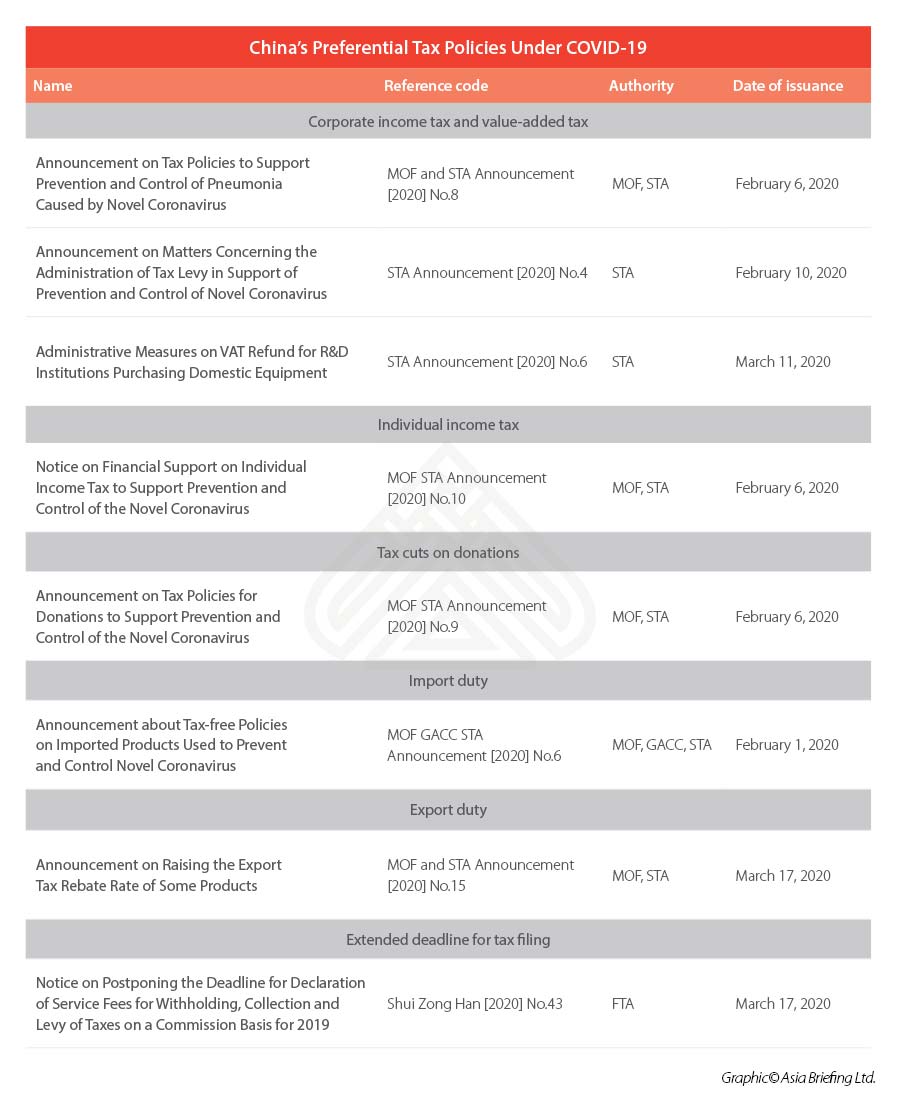
BritCham Guangdong connects and promotes businesses in the Greater Bay Area and bridges British business with Chinese enterprises. Every month BritCham Guangdong brings you news from our members which you may want to know about - Pulse offers you up-to-date industry insight through a 20-min read. BritCham Industry Pulse aims at joining the dots between our members and their market sectors.


How to Use China's Preferential Policies Rolled Out amid COVID-19
To contain the impact of COVID-19, authorities at all levels of government have been rolling out policies aimed at bringing Chinese society and economy back to normal. The various policies include fiscal support for the fight against the coronavirus, measures to ensure resumption of businesses, tax waivers, relaxations in social insurance obligations, subsidies for firms, and financial stimulus.
We have compiled a comprehensive list of policies (see here) issued by China's central and local governments for your easy reference, so interested parties can easily find the original government policy documents, their English versions, and the explanatory articles published on our website.
To help our readers better understand and leverage these policies, this article provides a holistic look on the policy directions of the Chinese government and explains key incentives of benefit to foreign investors.
We dissect the policies from four aspects – tax breaks, social insurance cuts, financial stimulus, and support for special industries and entities.
We advise businesses and individuals to first pay attention to the national polices, such as those released by the State Council and central ministries and then keep a watchful eye on whether the local government departments have released corresponding implementation measures.
Tax breaks
Businesses can pay attention to three documents:
MOF and STA announcement [2020] No.8(EN) issued on February 6;
STA Announcement (2020) No.4(EN) issued on February 10; and
STA Announcement [2020] No.6 issued on March 11;

For more details about tax breaks, social insurance cuts, financial stimulus, support for special industries and entities please click here.
This article was first published by China Briefing, which is produced by Dezan Shira & Associates.


COVID-19 APAC: COVID-19 Employment Issues Guide
Coronavirus (Covid-19) has had an unprecedented impact on all of us, including employers, who have had to adapt to the rapidly changing situation and deal with the substantial impact on their businesses. We are in unchartered territory but our expert employment lawyers are providing employers with clear and practical guidance on how to handle all the issues.
This guide considers some of the key issues and covers Australia, Hong Kong, Mainland China, Singapore, Cambodia, Laos, Myanmar, Thailand, Vietnam and Japan.
The guide covers the following topics
Annual leave, unpaid leave and reductionof hours during COVID-19
When can you lawfully “stand down” an employee without pay?
Immigration policy during COVID-19: Visa, work permits and residence
Latest quarantine measures
Data protection issues
Steps to protect the health and well being of staff
Self-isolation and social distancing – how they impact at work
Employee travel
Legal ramifications arising out of “work from home”
For more details about Clyde & Co's COVID-19 Employment Issues Guide, please click here


2020 HAYS Asia Salary Guide: Towards A Digitised And Flexible Future: Understanding Asia's Rapidly Evolving Recruitment Trends
Despite optimistic projections, 2019 meted out market uncertainties that had some industries bracing for impact. Marked by continued digital innovation and a slowing global economy, 2020 is expected to be a period of measured hiring and compensation where candidates must prove their worth and companies must match growing expectations to attract and retain them.

Impact of skill gaps becomes increasingly inevitable
While the majority of candidates believe their skills will continue to be relevant in the next five years (64 per cent), more are unsure of this (27 per cent) as compared to last year (24 per cent). This maybe a result of the economic uncertainty combined with the rapid digitalisation that continues to transform job markets across the region, resulting in a pressure to upskill.
Organisations are also increasingly aware of the impact skill shortages may have in the coming year. Just above half of all organisations (51 per cent) believe they have the talent needed to achieve their current business objectives, with Malaysia being the most confident (62 per cent) and Japan being the least (31 percent). The majority are also aware that skill shortages will hamper their business operations to some extent in 2020 (53 per cent), particularly productivity (62 per cent) and business development(45 per cent). While this is in line with last year’s findings, a new entrant onto this list is innovation and creativity (44 per cent), perhaps linked to ongoing digital transformation. China scored highest in this respect (58 per cent), while Hong Kong valued this the least (33 per cent). The majority of organisations also agree that a lack of training and professional development is the leading cause for such shortages in their industry (46 per cent).
A little over half the organisations believe teachable or technical hard skills to be the most sought after (54 per cent), with project management (58 per cent) and statistical analysis and datamining (55 per cent) at the top of this list. Among soft skills, problem solving (83 per cent), team work (75 per cent) and verbal communication (70 per cent) remain top priority for employers. More employers are also hiring contracting / temporary staff to meet peaks in demand (44 per cent), primarily those with technical or digital skills (37 per cent), tied with communication(37 per cent).
As our research shows, 2020 may be a challenging year ahead for employers and employees alike. But such market conditions present opportunities as well. Candidates with the flexibility to adapt or upskill in areas that will help organisations feel more equipped to face change will benefit the most. Similarly, organisations who can belay their fear and provide candidates with a conducive culture and generous compensation and benefits will attract the right candidates to their door and retain them for good.
For more findings about the 2020 Hays Salary Guide, please click here


5 must-do's on urban resilience in a time of Covid
The coronavirus (COVID-19) outbreak, which is having a huge impact on lives and assets, has brought a renewed focus on ‘urban resilience’ making us rethink the way we plan, design, develop and manage our cities to protect the health and wellbeing of the people when emergencies arise.
For cities to respond efficiently and effectively to urban crises, we need to be better prepared for every and any emergency. Equipped with meaningful data and information for use by local communities, we can make the right decisions about resources and operations, offering support to the people and areas where it matters. Responding to emergencies is a concerted effort, where communication and knowledge sharing becomes key to ensure citizen safety.
1. From single to multi-hazard resilience assessment
Traditional hazard assessment stresses focusing on a single hazard, whether it be flooding, earthquake, typhoons, or bush fires. But natural hazards do not elicit a single response. A fire may bring about dust storms, heavy rain resulting from typhoons can cause flooding, earthquakes may bring about tsunamis at the coastline or landslides in the inland areas. The development of a resilient city needs to move away from single hazard analysis to multiple hazards evaluation, and from silo operations of individual departments to collaborative and integrated efforts by professionals and the community at large. For instance, a super-typhoon and integrated catchment model developed for the South China Sea makes use of local bathymetry, topographic and historical super-typhoon data to estimate wave and rain-fall level under different hypothetical super-typhoon tracks. Combining this information with other climate variables including sea level rise, wind speed and precipitation, we can simulate the impact on local infrastructure under different combinations of hazards at different intensities, and formulate appropriate measures to cope with a variety of hazard scenarios that might happen in the future.
2. Plans for both proactive and reactive resilience
While we strive to plan, design and manage cities that can actively respond rather than react to emergencies, the unpredictability of urban crises drives the emergency services to react rather than respond. The city’s emergency response system is often designed around rescue work in the event of a crisis, focusing on post-disaster recovery and reconstruction. However, building urban resilience requires a more systematic and long-term approach – it is strategically deployed, based on the deep understanding of the city systems and transitions from reactive response to proactive adjustment. A resilient city strategy, therefore, covers the entire process from a more holistic and long-term strategy to mid-term action plans, and even project specific plans. Consequently, when the city is faced with a crisis it can be effectively managed and rapid recovery can be achieved, as the crisis would have been well anticipated, where all preparation work would have already been in place beforehand.
For more details about ARUP's 5 must-do’s on urban resilience in a time of Covid, please click here


2020全球媒体调查报告媒体行业的最新挑战和趋势
记者每年都会面临新的挑战。今年,由于新冠疫情在全球的传播及泛滥,对记者们而言注定是不平凡的一年。 虽然 Cision 在疫情宣布之前便发出了媒体现状报告调查问卷,但我们知道,新冠肺炎在 2020 年是不可能被忽略的:它已经对人们造成了影响,并将在可预见的未来继续影响我们。考虑到这一点,我们最近发出了一些专门针对新冠肺炎的补充问题,将在报告的特别章节进行讨论。 虽然今年很艰难且充满不确定性,但也有一些正面的情况需要强调:在记者眼中,对媒体的不信任度正继续减少。更多记者能够直面媒体偏见,发现媒体偏见时,他们应该改变自己的报道方法,使全球受众受益。 此外,公关人员和记者之间的关系也比以往任何时候都更重要,双方需要努力保持可靠和相互信任的关系以获取更多的资源。
主要亮点
• 新冠肺炎改变了媒体行业的一切,但对媒体来讲,还是有许多没有变化的东西
• 记者认为媒体的不信任继续减少,但这方面仍需努力
• 记者是人,而偏见在人类不可避免;我们探讨偏见和记者之间的关系(及和公关人员的关联)
• 社交媒体仍然很复杂,而对人工智能的期望不断下降
• 公关外联需要比以往任何时候更具针对性和关联性以脱颖而出
特别章节:
COVID-19 对媒体的影响随着新冠肺炎在全球泛滥,我们向记者了解此次疫情对他们的影响。他们的回答主要见下:
• 电子邮件、电子邮件、电子邮件:通过电子邮件向记者推介;这是记者提及最多的推介工具, 尤其是现在面对更大的工作量以及更少的资源,电子邮件更加重要。
• 现在我们都在家通过设备进行视频通话以及观看更多视频,让专家参与视频采访可谓是锦上添花。
• 现在推介时找准本地新闻角度尤为重要;每个国家的危机处理方式不同,许多受访者只对本地新闻推介感兴趣。
• 寻找新的新冠肺炎故事角度,推介正面故事。 正如一位受访者所说,“在这场危机中,我们都能获益于一点正能量。”
• 推介前公关人员必须继续研究媒体和记者。一些媒体已调用所有人员报道新冠肺炎新闻故事,其他类型的故事已经搁置。请务必了解记者现在的报道领域。
• 耐心。记者现在忙得不可开交,因此从他们那里得到回复可能比平常需要更长的时间。
欲了解更多关于2020全球媒体调查报告媒体行业的最新挑战和趋势,请点击此处。














